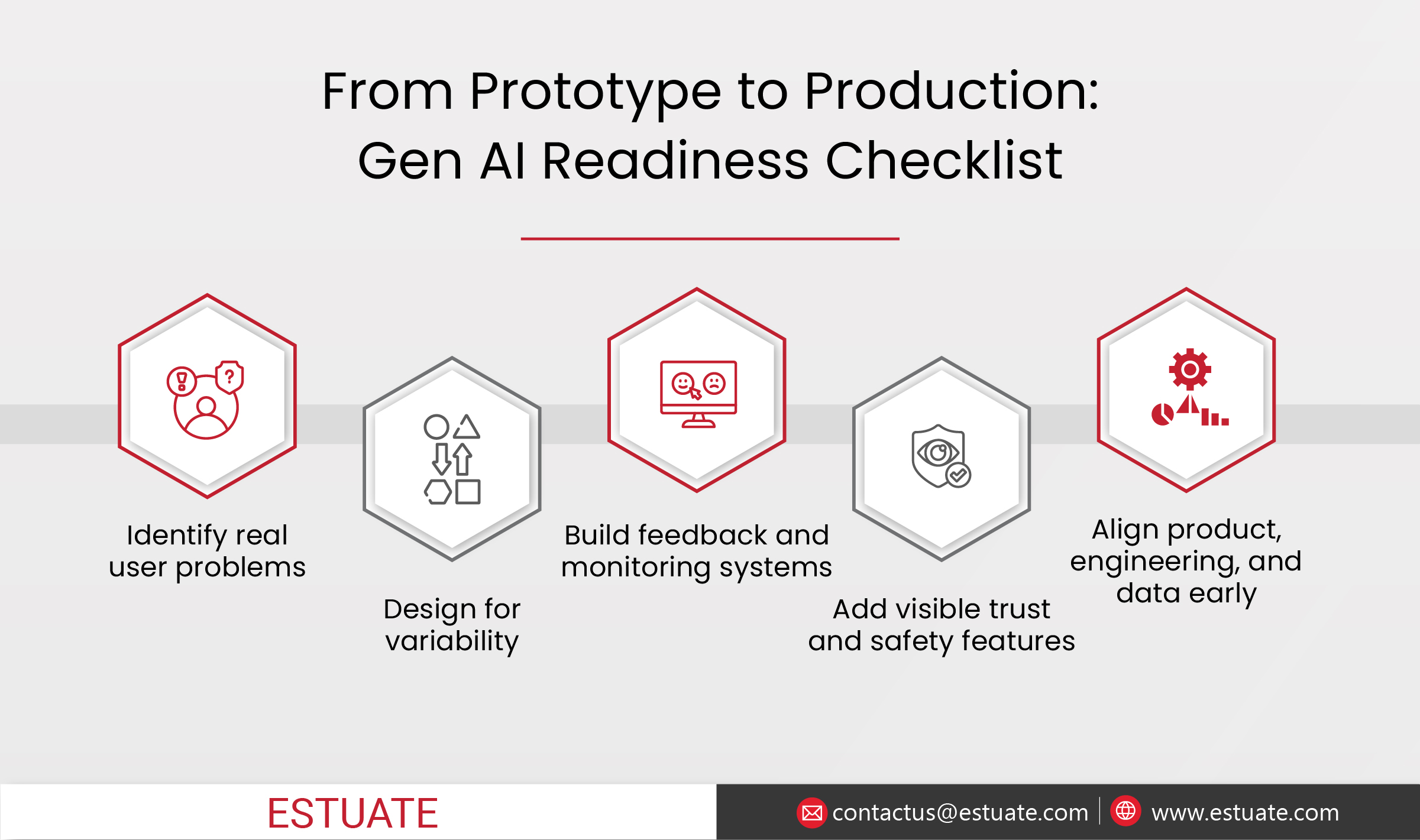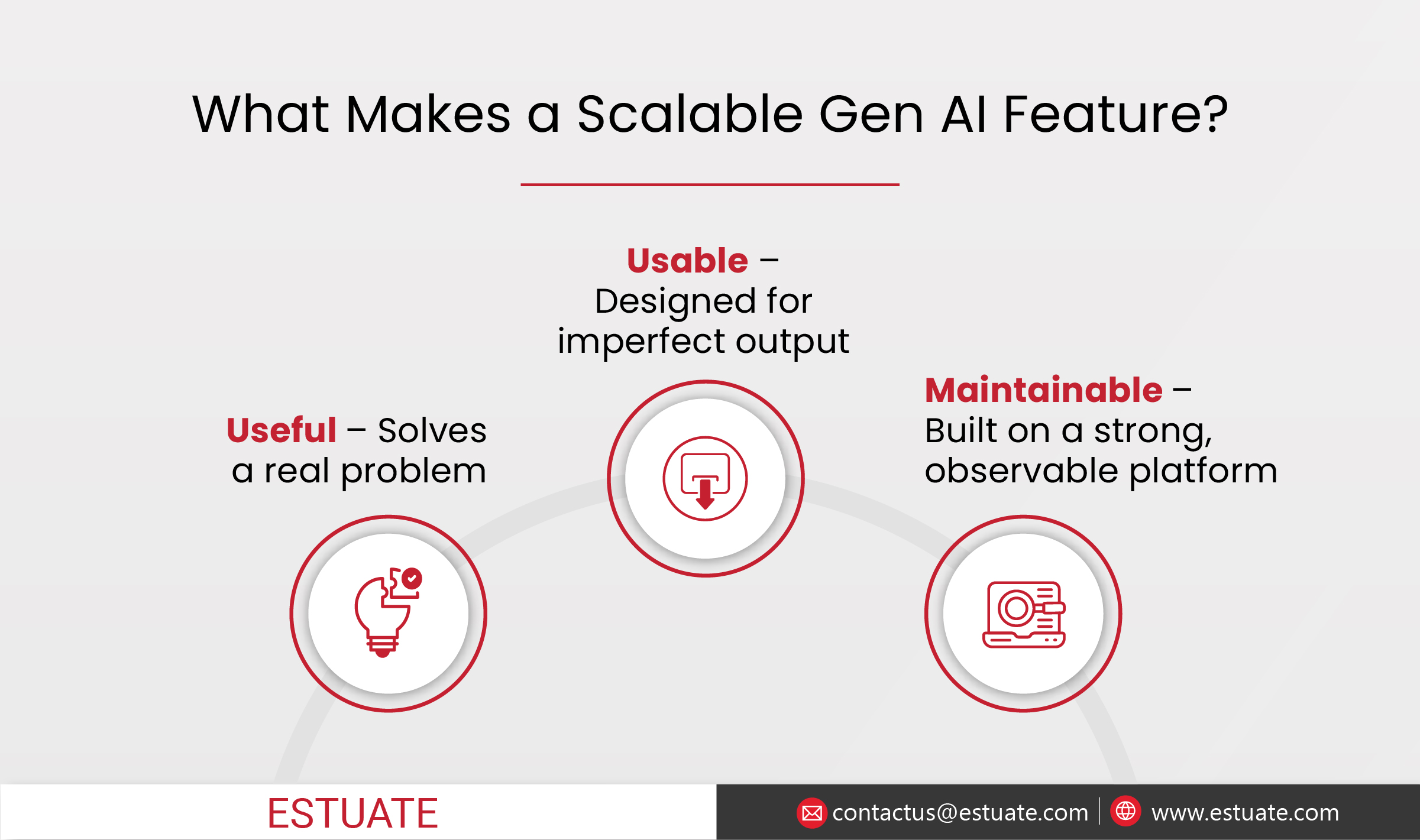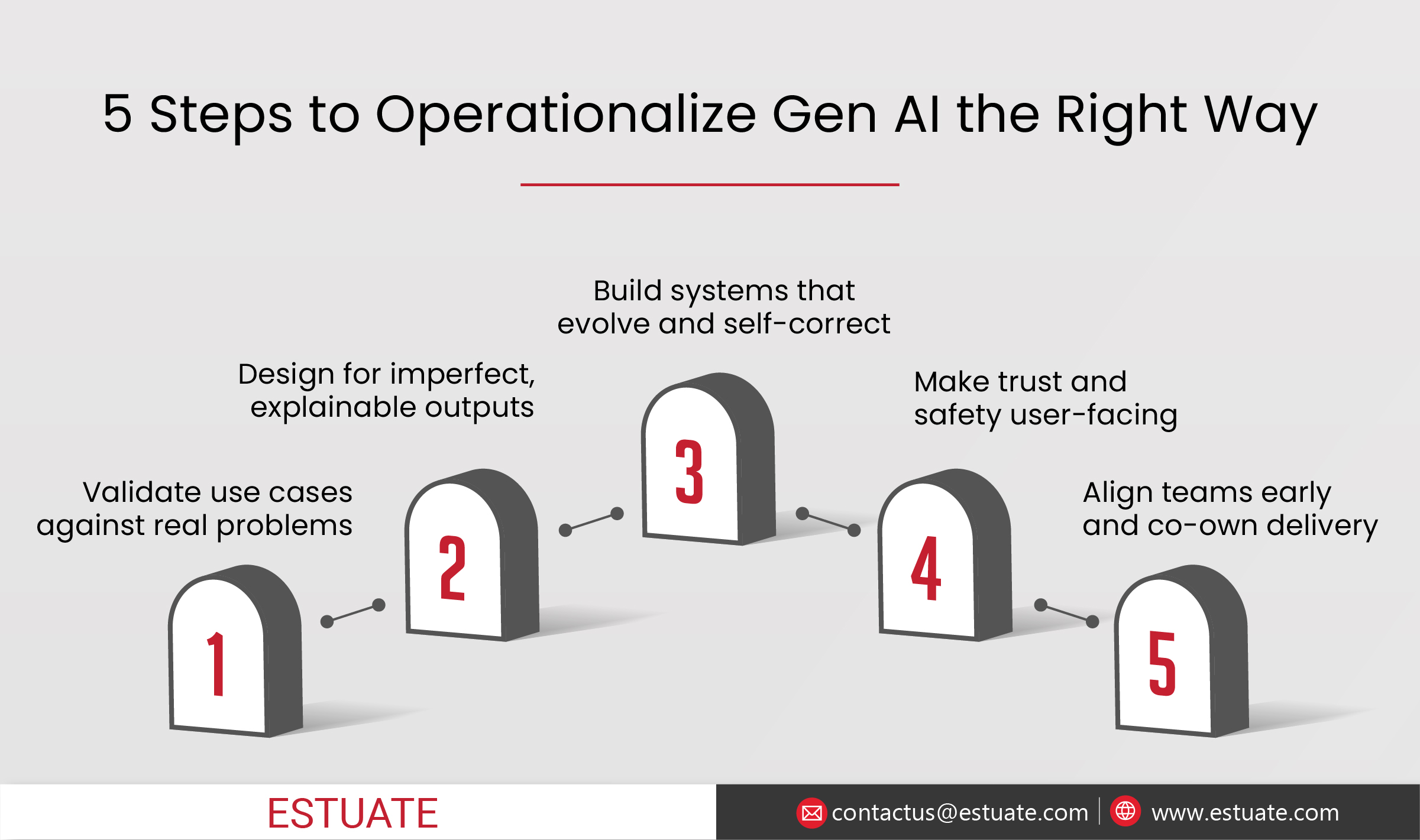What product and engineering leaders must get right to scale Gen AI from prototype to production

Generative AI is now a top priority for technology companies. It is no longer experimental. It is expected.
According to McKinsey, nearly 60 percent of organizations have piloted at least one Gen AI use case. Yet most are still stuck at the prototype stage. Few have managed to turn their experiments into scalable, reliable, and user-facing capabilities.
The reason is simple. Building a demo is fast. Operationalizing Gen AI in a product environment takes structure, discipline, and thoughtful execution across every layer from infrastructure to experience.
This guide outlines what it truly takes to get Gen AI working in production, not just in slides or sandbox environments.
“Building a Gen AI demo is easy. Making it scale inside a real product is where most teams fall short.”
From Prototype to Production: Gen AI Readiness Checklist
Start with Problems That Actually Matter
Not every workflow needs Gen AI. The goal is not to add a model, it is to remove a bottleneck. Teams that chase novelty often end up with features that look impressive but solve nothing.
“The strongest Gen AI use cases solve real friction—not just showcase a model.”
Build Gen AI Products That Scale
From prototype to production, Estuate helps you operationalize AI with
speed, trust, and structure.
The strongest use cases focus on core outcomes:
- Reduce repetitive, manual effort
- Speed up decisions with better insights
- Deliver clarity or value that conventional tools cannot
Before you write a single prompt, map out the biggest sources of friction in your product or process. Look at where users lose time, where support requests pile up, or where data overwhelms
decision-making.
Then ask, can Gen AI help resolve that friction in a meaningful way? If the answer is unclear, you are not ready to build.
Clarity at this stage saves months of wasted effort. Focus drives results.
What Makes a Scalable Gen AI Feature?
Design for Variability, Not Perfection
Gen AI is not deterministic. It does not produce the same result every time. That means your product experience needs to account for variation, edge cases, and occasional failure.
A system designed for predictability will break when Gen AI is introduced. Instead, you need a flexible experience layer that gives users context, control, and fallback options when the AI output is not ideal.
Some practical design elements to build trust include:
- Clear labeling of AI-generated content
- Options to edit or regenerate outputs
- Transparent explanations of what the model did and why
- Undo flows or manual overrides to correct errors
According to a 2024 Salesforce study, 73 percent of enterprise users lose trust in AI when it lacks context or choices.
Building for user trust is not about achieving perfect accuracy. It is about making the experience usable, understandable, and recoverable. If people understand the boundaries of what the AI can do, they will use it with more confidence—and provide better feedback to improve it.
Treat Infrastructure as an Always-On Product Capability
Most Gen AI prototypes are built in isolation, without thinking about long-term maintainability. The model is embedded directly in the feature. Prompts are fixed. Monitoring is an afterthought.
Then performance drops, bugs emerge, and teams scramble.
Sustainable Gen AI needs a mature foundation. That means treating your infrastructure like a living system, not a short-term project.
What this requires:
- Prompt versioning, testing, and optimization pipelines
- Logging and observability at both the system and model levels
- Feedback loops that track how users interact with AI outputs
- Continuous monitoring for model drift and performance drops
- Tools to tune, retrain, or swap models without rewriting your code
Without these in place, your AI feature may work on day one, but it will degrade quickly and become hard to maintain or evolve. Long-term performance depends on operational maturity, not model cleverness.
The Cost of Skipping MLOps
Make Trust and Safety a Visible Part of the Experience
Enterprise users care deeply about data governance, privacy, and explainability. These concerns are not compliance checklists. They are deal-breakers.
If your product cannot show what data is being used, how it is being processed, and how the output was generated, you are unlikely to earn customer trust or pass internal audits.
Build guardrails into the product interface, not just the backend. For example:
- Use badges to show which content is AI-generated
- Explain how the model arrived at a certain result
- Offer opt-in settings for data usage and personalization
- Expose fallback options when confidence is low
These features show customers that your product was designed with care, transparency, and responsibility. They help reduce anxiety around AI adoption and accelerate stakeholder approval, especially in regulated or risk-averse industries.
Trust is not just a technical issue. It is a product experience issue. Make it visible.
Enterprise Trust Signals for Gen AI Products
Break the Silos Between Product, Engineering, and Data
Gen AI success depends on collaboration. It is not something one team can solve in isolation.
When product engineering, design, and data teams work together from the start, the results are stronger and faster. The solution fits real user needs, ships faster, and is easier to scale.
That collaboration must begin early. Before building anything, align on three things:
- What user problem are we solving?
- What data and model will support it?
- What infrastructure is needed to deliver it reliably?
According to BCG, companies with cross-functional AI teams are three times more likely to move from pilot to full-scale deployment. The reason is simple. Alignment cuts through ambiguity.
If AI features are to succeed, everyone involved must own both the build and the outcome. That shared ownership is what drives real adoption and ongoing improvement.
“Gen AI done right is not just a tech win, it is a product milestone.”
Prototype. Operationalize. Scale.
Work with Estuate turn Gen AI ideas into secure, scalable product experiences.
Let’s Talk!
The companies that succeed will not be those who move first. They will be the ones who scale with clarity, care, and consistency.
How Estuate Helps You Operationalize Gen AI
Estuate works with leading SaaS and enterprise technology companies to build and scale Gen AI features that go beyond the demo.
We help you move from proof of concept to production with clarity, speed, and structure.
Our services include:
- Use case discovery and rapid prototyping
Identify opportunities that align with real business needs and validate them quickly with user feedback - Gen AI feature design and architecture
Integrate large language model capabilities into your existing platforms using scalable, cloud-ready design - Product engineering at scale
Build systems that support performance, observability, and iterative delivery - Responsible AI implementation
Apply governance, compliance, and trust frameworks from the beginning - DevOps and MLOps automation
Set up continuous deployment, feedback, and monitoring pipelines to keep your AI systems learning and evolving
With deep experience across industries and platforms, Estuate helps organizations bring Gen AI into their product roadmap in a way that customers trust and teams can manage.
5 Steps to Operationalize Gen AI the Right Way
Get Started
If you are ready to move from pilot to production with Gen AI, we are here to help.
Contact our team at contactus@estuate.com to schedule a consultation with our product engineering and AI experts. We will help you move from pilot to production with clarity, speed, and confidence.







